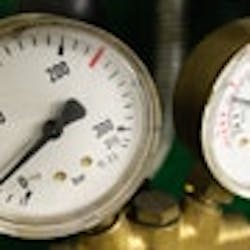Are VSD-controlled compressors best for regulating air pressure?
Figure 1. Airflow through an orifice as a function of pressure.
The idea of regulating the compressed air pressure of the whole plant from one location is a fairly new innovation. Operating a compressed air system at the lowest optimum pressure to meet the needs of production reduces energy cost. But there’s a controversy: Should compressed air pressure/flow control be used, or should modern compressor controls, especially VSD-controlled compressors, be used as an alternative to providing precise pressure regulation? Or is the best configuration using both?
What is artificial demand?
Artificial demand is defined as the excess volume of air that is required by unregulated end uses as a result of supplying higher pressure than necessary for applications. Compressed air flows from the compressed air system to atmosphere through an opening or hole in the system. That opening could be a leak, an air tool, a pneumatic cylinder, control valve or other production application. If there’s a hole or orifice in the air system, increasing compressed air pressure increases the airflow (Figure 1).
Flow rates for various orifice sizes and pressures are shown in Table 1. A 10-psig reduction in air pressure causes approximately 10% less compressed airflow.
| Orifice (in.) | Pressure (psi) | ||
| 90 | 100 | 125 | |
| 1/16 | 5.92 | 6.49 | 7.9 |
| 1/8 | 23.7 | 26 | 31.6 |
| 1/4 | 94.8 | 104 | 126 |
| 3/8 | 213 | 234 | 284 |
| 1/2 | 379 | 415 | 506 |
Table 1. Flow rate (in SCFM) for various orifice sizes (Source: Best Practices for Compressed Air Systems) |
|||

